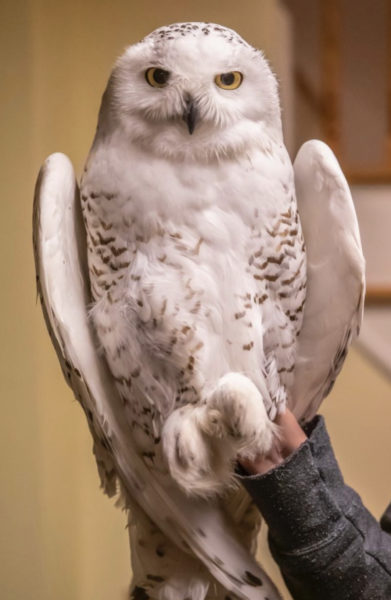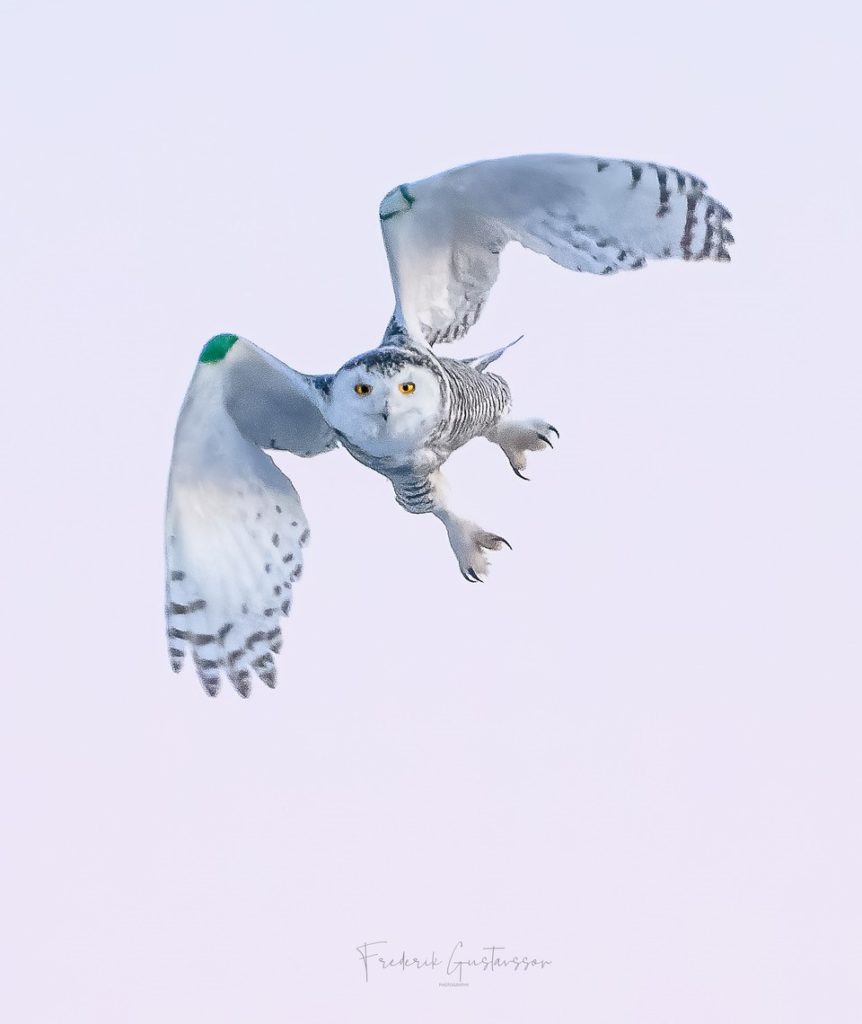
Members of the New York tagging team pause while fitting Britton with a transmitter — in the foreground from left, banders Melissa Mance-Coniglio and Barbara French, at rear former veterinary technician Jennifer Lang and core SNOWstorm team member Tom McDonald. (©Aaron Winters)
This winter has been dominated mostly by news of our many returning snowies, with only three newly tagged owls, all relocated from the Montréal airport — Aimé, who immediately returned to the airfield and was killed by the back-blast of a taxiing jet, and Nicolet and Odanak, both of whom also returned to the airport but have thus far mostly remained off the runways. It’s been a challenging trapping winter otherwise.

Roc, an after-fifth-year female captured at the Douglass Rochester airport. (©Aaron Winters)
But in the past two weeks we’ve added three newly tagged owls, including two in upstate New York — though none of them have behaved the way we wanted them to, showing how strong the homing instinct can be once a snowy owl has established its winter site.
Several times this fall, veteran snowy owl bander Tom McDonald and his team, including bander Melissa Mance-Coniglio, have tried trapping snowies that were wintering at the Frederick Douglass Greater Rochester International Airport in Rochester, NY. An attempt in late January resulted in a number of close passes by the owls but no capture, but on Feb. 10 Tom and his team captured an adult female at least six years old, based on her molt, and tipping the scale at a plump 2,132 grams (4.7 pounds). Nicknamed Roc, for the Rochester airport, she was fitted with one of our standard GPS/GSM transmitters from CTT and transported 55 miles (87 km) southeast to the Finger Lakes farmland between Seneca Lake and Lake Cayuga.

It took Roc almost two weeks, but both she and Britton wound up back at the Rochester airport. (©Project SNOWstorm and Google Earth)
Two days later, on Feb. 12, Tom and Melissa’s team captured two additional owls at the airport, and moved both of them 41 miles (66 km) southwest near the Genesee River in Wyoming County, NY. One of them, an immature female, was fitted with a transmitter and dubbed Britton, named for historic Britton Field, the 1919 forerunner of the Douglass-Rochester airport. (The other owl, a juvenile male, was banded but released without a transmitter.) An adult male at the airport has thus far eluded capture, but we’re still hopeful Tom’s crew may catch and possibly tag him as well.

Bleuet, her wing joints dyed green like all owls relocated from the Montréal airport, on the attack. (©Frederik Gustavsson)
Finally, on Feb. 16 the biologists at Falcon Environmental in Montréal recaptured an immature female, first trapped at the Trudeau-Montréal airport Jan. 3 and relocated far away. (At that time, as with all of their relocated owls, Falcon marked its wings with temporary green dye so it could be identified at a distance if it showed up again.) This time Dr. Guy Fitzgérald at the University of Montréal fitted her with the undamaged transmitter recovered from Aimé, and she was released later that day 66 km (41 miles) away in agricultural lands northeast of the city, on the north shore of the St. Lawrence between Joliette and Trois-Rivières. She’s been nicknamed Bleuet for the abundance of blueberry fields near her release site.

Dr. Guy Fitzgérald of UQROP (Union Québécoise de Réhabilitation des Oiseaux de Proie) tags Bleuet with help from wildlife veterinarian Dr. Marion Jalenques, left, and UQROP biologist and educator Audrey Maynard. (©UQROP)
Not that Bleuet stayed there long — in fact, maybe we should have dubbed this trio Boomerang 1, 2 and 3. Bleuet wasted little time, and within three days she was back at the airport, where she joined Nicolet, Odanak and Hochelaga — and unlike those three, she spent most of her time near the active runways. It took Britton eight days, and a looping flight first southwest and then back northeast, before she returned to the Rochester airport. Because Roc remained for nearly two weeks near her release site, we were hopeful she’d stay put, but Feb. 23-24 she also flew back to the Rochester airfield.
* * * * *

Staking out their turf: The movement limits of Bleuet (blue), Odanak (red), Nicolet (purple) and Hochelaga (green). (©Project SNOWstorm and Google Earth)
Here’s a quick update on everyone else we’re monitoring this winter.
As noted, Nicolet, Odanak and Hochelaga remain on and around the Montréal airport, although Odanak has flown as much as 14 km (9 miles) away to spend some ice-time on Lake of Two Mountains, and also to the Saint-Laurent neighborhood to the north of the airport. Nicolet and Odanak have staked out relatively small territories at either end of one of the three main runways, where there is a lot of grass; Nicolet in particular rarely stirs from her 30 hectare (75-acre) activity range, which includes the margins of a highway that runs under the east end of the airport. Neither she nor Odanak seem to encroach much on the runway, but their proximity is obviously worrisome, and as with any of the boomerang owls, if they can be retrapped they’ll be moved again.
Hochelaga is mostly hanging out on and around the big hanger buildings surrounding the airport, in the industrial neighborhoods to the northeast and along the Trans-Canada Highway that runs close to the airport.
Yul, named for the Montréal airport’s alpha code YUL, remains blessedly far from her namesake, once again this winter sticking close to her 2020-21 territory on the south side of the St. Lawrence in quiet farmland. Likewise, Wells has been regular as clockwork in her usual haunts in Québec City, and Otter hasn’t made any flights away from his choice spot this winter near Lake Abitibi in western Québec.

Stella’s moved southwest a bit, to near the Qu’Appelle River Dam in southern Saskatchewan. (©Project SNOWstorm and Google Earth)
In the northwest of Michigan’s Lower Peninsula, Fond du Lac seems to really like it near the Crown Golf Club and the homes adjacent to it near Traverse City. On the other hand, Columbia’s been moving around a fair bit north of Fargo, North Dakota, and Stella moved about 43 km (27 miles) southwest from where she’d been all winter near Craik, Saskatchewan, to near the Qu’Appelle River Dam. Such late-winter movements are common as the lengthening days start working on the owls, and we’ll probably see more of them in the coming weeks.


8 Comments on “One, Two, Three New Owls”
I have followed the movements of Project Snow Storm owls that moved through Saskatchewan starting with Pettibone and including Argus, Columbia and Stella. The information being collected by this project is amazing. I have had a life-long interest in Snowy Owls and all raptors including banding and color-marking a few snowy owls in Saskatchewan in the early 1970`s near Saskatoon. Some of them remained in the local area and some weren`t seen again. I always wondered where they went but your research is filling in the blanks. The only band return was from South Dakota in a following winter.
I was able to locate Argus last winter in eastern Saskatchewan based on subsequent map locations after the fact. During daylight hours he was always roosting on the ground up to half a mile off the road so I never was able to see his back pack. In contrast it is interesting that some of the night locations were correlated to a line of tall hydro poles running through the area.
I was able to locate and photograph Stella and her back pack on December 3, 2021 and February 12, 2022. It appears to be an older style transmitter and was impossible to see when viewed from a side profile. When viewed directly from the rear it was almost completely covered by feathers. Only a very small portion of the solar panel was visible because of the feathers and because the solar panel is oriented to the posterior portion of back pack. If the orientation had been reversed then approximately 1/3 of the solar panel would have been exposed to the sun. I realize his is old news based on the revised design of the newer transmitters and these comments are intended as information only and not criticism. The back pack was clearly visible from the rear when the owl was flying. In contrast to the area used by Argus in eastern Saskatchewan the area used by Stella near Craik does not contain any high perches such as hydro poles. If you are interested in photos of Stella just send me an e-mail address. I am interested in being involved in the project. If I can be of help as boots on the ground to confirm locations or information on habitat just let me know.
Adam, thanks so much for your detailed observations, and I’ll be in touch directly by email about photographs. As for the transmitter design, as you note we’re constantly working with our partners at CTT (and the Maryland Zoo, which allows us to test new designs on their captive, non-display snowy owl) to refine the case design and other elements to produce the best mix of minimum weight, good solar recharge, long battery life and comfortable fit for the bird.
Thanks so much for the great update on these snowy owls. I am fascinated by the work you are doing to keep track of these guys. I have photographed these guys for a number of years snow specifically in Ontario north of Toronto.
It would be nice to see one being tracked in our area.
I’m wondering what the prey base is at so many airports that can support such concentrations of Snowy Owls. Are there that many rodents in surrounding fields, or are they taking birds (which airports presumably try to discourage)? A Snowy in Cambridge, MD has been living the good life this winter, dining on duck daily, plucked from the large flock attracted to the riverfront by a long-time (unofficial) feeding habit.
It depends on the airport; we’ve had owls that use the flat terrain for roosting but do most of their hunting in surrounding waters (as is often the case at Logan Airport in Boston), while other snowies hunt mammals and birds on the grassy expanses, which can be thick with meadow voles and cottontails. One Logan owl we were tracking (Salisbury) roosted the airport but flew across the Charles River at night to hunt rats near a large brewery. Our colleague Norman Smith, who has been working with those snowies at Logan since 1981, has long argued that the owls are far less of a danger to planes than flocking birds (since the real danger to a jet is having both of its engines taken out at once; they can fly with just one engine). Norman feels the snowy owls actually increase airfield safety by preying on flocking birds like waterfowl, corvids, pigeons and starlings that would be more likely to take down a plane.
If you want to see some of the snowy owls of Montreal airport that I had the chance to follow between 2007 and 2019 here’s some pictures and videos .
You can also see what is the main meal for theme at that airport.
Photos:
Aéroport ADM Airport 2007-2019
https://photos.app.goo.gl/c8xXHn2VJFvoQNFp8
Videos:
https://www.youtube.com/watch?v=BvuKGcICkKk&list=PLO3zuyPPmwz4isO8sDltbAc2_81HHokLu
Cheers!
Thanks, Richard — great photos and a fun video of the snowy owl on the anemometer!
Scott, you and your team are doing a wonderful job with the owls. Thanks for sharing that with the public and in a way it is very interesting and easy to follow and understand. I’ve always felt there was a disconnect with knowledge collected by scientists and shared with the public. Your reports does an excellent job of connecting that link.